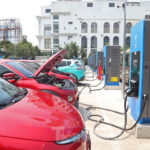The trend towards green transportation has led to major cities like Hanoi and Ho Chi Minh City implementing stricter regulations to curb gasoline vehicles and encourage a shift to electric vehicles. Incentives such as registration fee support and the expansion of charging stations are being employed to bolster efforts to reduce emissions.
However, while electric vehicles are considered a sustainable solution for urban transportation, many ride-hailing drivers have expressed concerns and hesitations about transitioning from their familiar gasoline cars.
Recently, ride-hailing drivers have been considering switching from gasoline to electric vehicles to save on fuel costs and reduce expensive maintenance expenses. Mr. Nguyen Thanh Ven, a ride-hailing driver, shared his experience: “About a year ago, I started driving an electric car. With a gasoline car, I spent about 100,000 VND on fuel daily, but now with an electric car, I only spend about 20,000 VND on electricity, which is a significant saving, and I don’t have to change the oil either.”
Mr. Ven is not alone in his reasoning; many other drivers have opted for electric vehicles for similar reasons. Another driver explained, “I decided to switch to electric because it’s a little more economical. Electric cars are also smoother and more compact.”

Mr. Nguyen Van An, a long-time ride-hailing driver, also made the switch to an electric vehicle to save on costs
Mr. Nguyen Van An, a veteran ride-hailing driver, carefully considered his decision to switch to an electric vehicle: “With gasoline, I spent almost 100,000 VND daily, but with electric, it’s cheaper, and I don’t have to worry about changing oil or maintaining the chain, sprocket, and disk.”
Nevertheless, some drivers remain apprehensive. Mr. Le Thanh Hai, who still drives a gasoline car, pointed out some inconveniences associated with electric vehicles: “Even though electric cars are more economical, they can be inconvenient for drivers. For example, if the car breaks down on the road, it takes at least ten days to get it serviced. With a gasoline car, even if you spend fifty thousand VND on fuel, it’s more flexible because you can easily find a repair shop anywhere if you have a flat tire or a breakdown.”
Sharing the same sentiment, Mr. Tran Quoc Truong mentioned another obstacle—the limited charging infrastructure, especially in rural areas: “It’s even more challenging in rural areas because not everyone can afford an electric car. It’s difficult to take an electric car to the countryside because there are no charging stations. For example, if a husband and wife each have a car, it’s unlikely they can both afford to switch to electric.”

Many drivers still have concerns about charging stations

“There’s no guarantee how long electric vehicle batteries will last. In general, they seem stable initially, but their long-term performance remains to be seen,” expressed another driver.
It is evident that despite the inevitable shift towards electric vehicles for greener transportation and fuel cost savings, several barriers still cause hesitation among ride-hailing drivers. From the lack of synchronized charging infrastructure and initial investment costs to concerns about battery longevity and fire hazards, these challenges require satisfactory solutions.
For electric vehicles to truly become a safe, convenient, and long-lasting choice, more time, supportive policies, and synchronized investments are necessary to ensure that each trip is not only economical but also safe and sustainable for both individuals and the city.
Photos, Clips: Di Anh
“Fire Safety First: Why Dorms and Apartments Should Focus on Fire Hazard Prevention Rather Than Electric Vehicle Bans”
The reluctance of some apartment buildings and landlords to accommodate electric vehicle charging is understandable, given the lack of established risk management and fire safety measures. To address this challenge, it is imperative for residential communities to take the lead in developing a comprehensive and civilized electric vehicle management model.
The Optimized Headline:
“Hanoi’s Cua Nam Ward Responds to the ‘Pilot Gasoline Vehicle Ban’ Proposal”
The Hanoi People’s Committee of Cu Nam Ward has responded to media reports regarding a proposed ban on gasoline-powered vehicles in the ward. The committee clarified that while they are considering measures to reduce air pollution and encourage the use of electric vehicles, no final decision has been made. The trial, if successful, could see a wider implementation across the city.













































